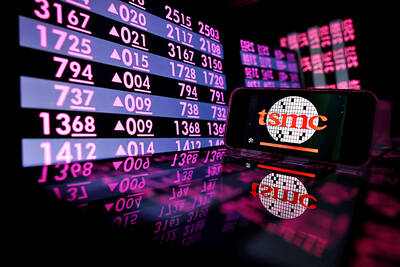Smartphone camera lens maker Largan Precision Co (大立光) yesterday reported that last quarter’s consolidated revenue fell 10.31 percent from the previous quarter and was also down 15.31 percent year-on-year to NT$8.19 billion (US$263 million).
The second-quarter figure represents the company’s lowest quarterly level since 2013, while its revenue in the first half of the year was NT$17.33 billion, down 12.51 percent from the same period last year, Largan data showed.
Taichung-based Largan is a global company that designs, produces and assembles high-end optical lenses.

Photo: CNA
The company’s customers include Apple Inc, Samsung Electronics Co and several Chinese brands, while its main competitors are Genius Electronic Optical Co (玉晶光) in Taiwan and Sunny Optical Technology Group Co (舜宇光學) in China.
High-margin 20-megapixel or more lenses for smartphone cameras accounted for 20 to 30 percent of the company’s total sales last month, Largan said in a statement.
The majority, or 50 to 60 percent, came from sales of 10-megapixel lenses, while 8-megapixel lenses contributed less than 10 percent, it said.
Handset vendors are still planning specification upgrades for high-end models, and Largan is also designing “G+P” (glass and plastic) lenses to meet client demand.
However, the company’s second-quarter and first-half sales reflect that the global demand for smartphones is still weak as vendors remain cautious about purchasing high-end lenses.
Nonetheless, there is a positive sign in the firm’s business climate as last month’s revenue rose 2.67 percent month-on-month, following a sequential decline of 8.53 percent in May.
At the company’s annual general meeting in Taichung earlier last month, Largan chief executive officer Adam Lin (林恩平) said the company’s sales last month would be higher and better than May, and sales this month would also be higher than last month.
As the second half of a year is traditionally the peak season for the smartphone industry, Lin told shareholders that he expected the company’s business to show improvement in the upcoming months.
However, sales growth in the second half would not be as strong as in the previous years, with vendors’ confidence in the market remaining weak and inventory adjustments in the supply chain continuing, he said.
Largan is to hold an investors’ conference on Thursday next week to share financial figures for last quarter and a business outlook for this quarter.

Taiwan Semiconductor Manufacturing Co (TSMC, 台積電) yesterday said that its investment plan in Arizona is going according to schedule, following a local media report claiming that the company is planning to break ground on its third wafer fab in the US in June. In a statement, TSMC said it does not comment on market speculation, but that its investments in Arizona are proceeding well. TSMC is investing more than US$65 billion in Arizona to build three advanced wafer fabs. The first one has started production using the 4-nanometer (nm) process, while the second one would start mass production using the

When an apartment comes up for rent in Germany’s big cities, hundreds of prospective tenants often queue down the street to view it, but the acute shortage of affordable housing is getting scant attention ahead of today’s snap general election. “Housing is one of the main problems for people, but nobody talks about it, nobody takes it seriously,” said Andreas Ibel, president of Build Europe, an association representing housing developers. Migration and the sluggish economy top the list of voters’ concerns, but analysts say housing policy fails to break through as returns on investment take time to register, making the

‘SILVER LINING’: Although the news caused TSMC to fall on the local market, an analyst said that as tariffs are not set to go into effect until April, there is still time for negotiations US President Donald Trump on Tuesday said that he would likely impose tariffs on semiconductor, automobile and pharmaceutical imports of about 25 percent, with an announcement coming as soon as April 2 in a move that would represent a dramatic widening of the US leader’s trade war. “I probably will tell you that on April 2, but it’ll be in the neighborhood of 25 percent,” Trump told reporters at his Mar-a-Lago club when asked about his plan for auto tariffs. Asked about similar levies on pharmaceutical drugs and semiconductors, the president said that “it’ll be 25 percent and higher, and it’ll

CHIP BOOM: Revenue for the semiconductor industry is set to reach US$1 trillion by 2032, opening up opportunities for the chip pacakging and testing company, it said ASE Technology Holding Co (日月光投控), the world’s largest provider of outsourced semiconductor assembly and test (OSAT) services, yesterday launched a new advanced manufacturing facility in Penang, Malaysia, aiming to meet growing demand for emerging technologies such as generative artificial intelligence (AI) applications. The US$300 million facility is a critical step in expanding ASE’s global footprint, offering an alternative for customers from the US, Europe, Japan, South Korea and China to assemble and test chips outside of Taiwan amid efforts to diversify supply chains. The plant, the company’s fifth in Malaysia, is part of a strategic expansion plan that would more than triple